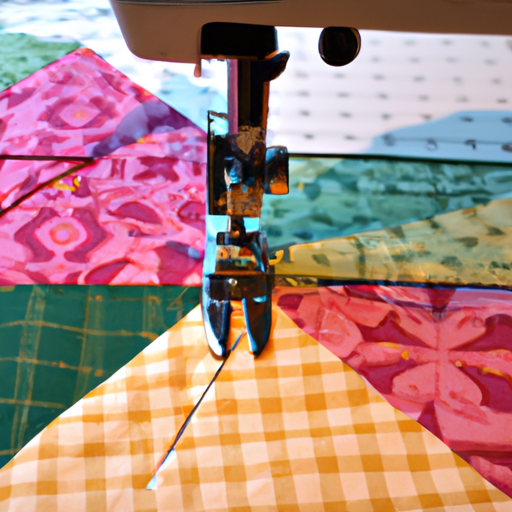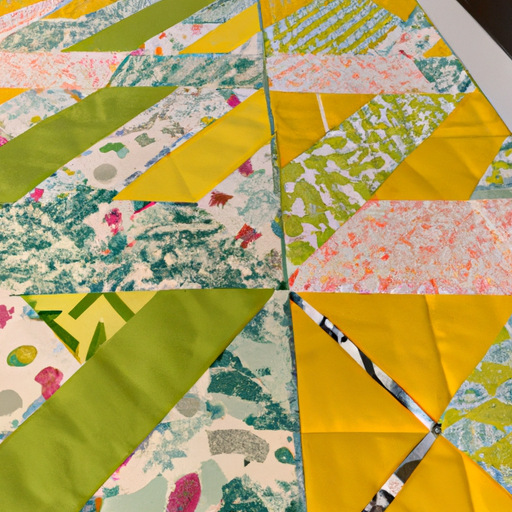
Can you straight line quilting without a walking foot?
Do you ever find yourself staring at your quilting projects, wondering if you can take it to the next level with straight line quilting? You envision your piece, intricately detailed and perfectly stitched, but there’s one hurdle in your way: the dreaded walking foot. It seems like an essential tool for any quilter, but what if we told you that you could achieve that flawless straight line stitching without it? Yes, you read that right, and we’re here to show you how. So, fellow quilters, get ready to grab your quilting gloves and join us as we embark on this magical journey of straight line quilting without a walking foot. Get ready to be amazed and inspired as we learn to quilt like royalty, sans walking foot!
1. „Breaking the Rules: How to Straight Line Quilt without a Walking Foot“
Quilting can be a fun and relaxing craft, but when it comes to straight line quilting, some of us just can’t handle the extra bulk of a walking foot. It’s a bit frustrating when we try to sew without it and end up with uneven stitches or puckering. But guess what, my fellow quilters? We can actually start breaking the rules and straight line quilt without a walking foot!
First things first, let’s set up our machine properly. Make sure your presser foot pressure is adjusted and your tension is correct. Also, choose a longer stitch length than you normally would. This will help your fabric feed through the machine more smoothly.
Next, it’s all about your technique. The key to quilting without a walking foot is to keep your fabric taut as you sew. This means using both your hands to guide and control the fabric. And speaking of hands, don’t be afraid to take breaks and stretch your fingers. Trust me, they’ll thank you later.
Another great tip is to alternate the direction of your lines. This will help distribute any tension and prevent your fabric from bunching up. Plus, it’ll give your quilt a cool, modern look. And if you want to add some extra texture, try quilting in a diagonal or crosshatch pattern.
Finally, don’t be too hard on yourself if your stitches aren’t perfect. Quilting is all about imperfection and embracing the handmade nature of the craft. So go ahead, break the rules, and see where your creativity takes you. Who knows, you might just end up with a masterpiece that you can proudly display in your home or gift to a loved one. Happy quilting!
2. „The Battle of the Footless: Conquering Straight Line Quilting“
Straight line quilting can be incredibly tricky, but it can also make or break the look of your quilt. It’s something that takes time, patience, and a heck of a lot of practice. I remember when I first started quilting, I was terrified of straight line quilting. It seemed like no matter how hard I tried, all my lines were crooked, and the quilting looked messy.
But then, I discovered the battle of the footless. This is where you take the presser foot off your machine and use the edge of your walking foot as a guide. It was a game-changer for me. Suddenly my lines were straight, and my quilting looked neat and tidy.
Of course, there are a few things you need to do to prepare your quilt for straight line quilting. The most important thing is to baste your quilt properly. You don’t want your layers shifting around as you’re quilting as it will lead to uneven stitching. It’s also a good idea to mark your quilt with guidelines using a washable pen or painter’s tape if you want a specific design.
One tip to keep in mind is to use a longer stitch length when straight line quilting. It helps to keep your lines straight and gives your quilt more movement. Also, take your time. Straight line quilting can be time-consuming, but it’s worth it in the end. You’ll be amazed at the difference in the look of your quilt.
In conclusion, the battle of the footless is one that all quilters should learn to conquer. It’s the key to achieving neat and tidy straight line quilting. With practice, patience, and the right preparation, you’ll be quilting up a storm in no time. So take a breath, put your foot down (or, in this case, take it off!), and get ready to conquer straight line quilting!
3. „Taming the Beast: Mastering Straight Line Quilting with No Foot“
Straight line quilting can seem intimidating to many beginners. But with practice, patience, and a little bit of guidance, anyone can learn to tame the beast that is straight line quilting. And the best part? You don’t even need a foot to get started.
First and foremost, mastering straight line quilting without a foot requires a steady hand. This means taking the time to practice your stitching technique and getting comfortable with the rhythm of the machine. Once you have that down, you can start experimenting with different patterns and designs.
One technique that can be particularly effective in straight line quilting is the use of rulers. By using a quilting ruler, you can create sharp, precise lines that add depth and dimension to your quilt. And don’t be afraid to mix and match different ruler sizes and styles to create unique designs.
Another important aspect of mastering straight line quilting is proper tension. This can be a bit tricky to get the hang of, but with practice and patience, you can easily adjust your machine’s tension to get the perfect stitch. And remember, a little bit of variation in your stitch length can add some visual interest to your quilt.
Lastly, don’t be afraid to embrace imperfection. Quilting is an art form, and as with any art, there is beauty in the unexpected. So don’t stress too much about perfectly straight lines – a little bit of variation can add character and personality to your quilt.
In the end, straight line quilting without a foot can be both a challenging and rewarding experience. So don’t be afraid to dive in, experiment with different techniques, and most importantly, have fun!
4. „The Ultimate Quilting Challenge: Unleashing Your Creativity without a Walking Foot“
Are you ready to take on the ultimate quilting challenge? It’s time to unleash your creativity and create something truly unique. But wait – there’s a catch. You’re not allowed to use a walking foot.
That’s right. This challenge is all about breaking free from traditional quilting techniques and exploring new ways to stitch. Without the walking foot, you’ll have to rely on your own skills and ingenuity to create beautiful, functional quilts that will make your heart sing.
So how do you do it? Here are a few tips to help you get started:
– Start with a solid plan. Without the walking foot, your stitches may be less predictable, so it’s important to have a clear vision of what you want to create before you begin.
– Experiment with different techniques. Without the constraints of the walking foot, you can try out different stitching patterns, free-motion quilting, and even hand quilting to create unique textures and designs.
– Don’t be afraid to make mistakes. It’s all part of the learning process, and sometimes the most beautiful quilts come from unexpected detours.
Remember, this challenge is all about unleashing your creativity and exploring new possibilities. So don’t be afraid to go outside your comfort zone and try something new. We can’t wait to see what you create!
5. „The Power of Imagination: Achieving Perfect Straight Lines without a Walking Foot“
Are you tired of struggling to get perfectly straight lines in your sewing projects? Do you feel like you’re limited by the capabilities of your equipment? Don’t despair, because there’s a solution that doesn’t require a walking foot: the power of your imagination.
With a little bit of creativity and visualization, you can achieve straight lines that are just as clean and precise as if you were using a walking foot. Here are some tips to get you started:
– Picture the line in your mind before you begin sewing. Imagine it exactly as you want it to be: straight, even, and consistent. This will give you a mental image to strive for as you sew.
– Use a guide of some kind to help you keep your line straight. This could be as simple as a piece of tape or a ruler, or as creative as a line of chalk or a piece of embroidery floss. Whatever method you choose, make sure it’s easy to see and follow.
– Slow down and take your time. Don’t rush your sewing, especially when you’re working on a straight line. Careful, deliberate movements will help you stay on track and produce the best results.
Remember, the power of imagination is a valuable tool for any creative endeavor, and sewing is no exception. By using your mind’s eye to guide your stitches, you can achieve results that are just as impressive as if you were using the most advanced equipment. So take a deep breath, let your imagination run wild, and sew those straight lines with confidence and skill.
6. „From Novice to Expert: Discovering the Secrets to Straight Line Quilting without a Walking Foot
Straight line quilting without a walking foot can sound like a daunting task for new quilters. But don’t get discouraged! With practice and patience, you too can become an expert at this technique.
One secret to straight line quilting is to use an even-feed foot or differential feed foot. These feet work similarly to a walking foot, helping to evenly guide the fabric through the machine. Another helpful tip is to mark your quilt top with a ruler and fabric pen, creating a guide for your stitching.
If you’re struggling with keeping your lines straight, don’t be afraid to use masking tape as a guide on your fabric. Place the tape on either side of where you want to sew, and follow it with your stitching. Remember to use a longer stitch length to make it easier to follow your guide.
Practice makes perfect when it comes to straight line quilting. Take the time to make a practice piece before starting on your quilt top. This will give you the opportunity to perfect your technique and build your confidence.
With these tips and a little bit of determination, soon you’ll be straight line quilting like a pro without a walking foot. Start practicing today and see how far you’ve come in just a short amount of time! Quilting is not just an art, but a passion that connects us to the memories of our past and present. As crafters, we strive to achieve the perfect stitch, the perfect curve, and the perfect line. And today, we proved that we can achieve this perfection even without a walking foot.
We have shared our tips and tricks to successful straight line quilting without a walking foot – from setting your machine to the right stitch length to using tape as a guide. But beyond the technicalities, we have also shared our love for the craft and the satisfaction it brings us.
Because at the heart of quilting is the joy that it brings to our lives. It is a reminder that even in the mundane, we can create something beautiful. So whether you choose to use a walking foot or not, remember to embrace the imperfections and the beauty that they hold.
We hope that this article has inspired you to get creative and try new things. And always remember, with passion and perseverance, anything is possible. Happy quilting!